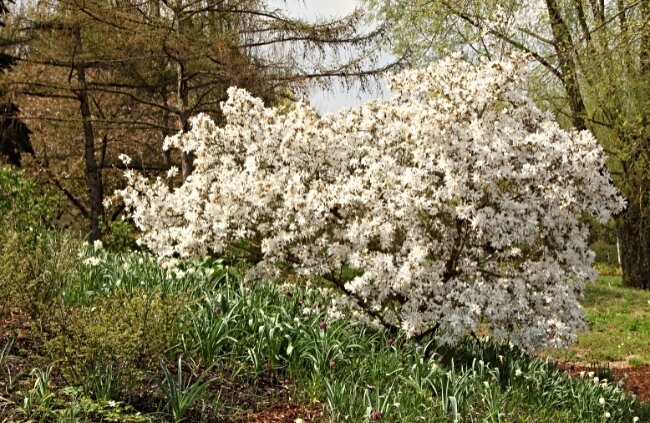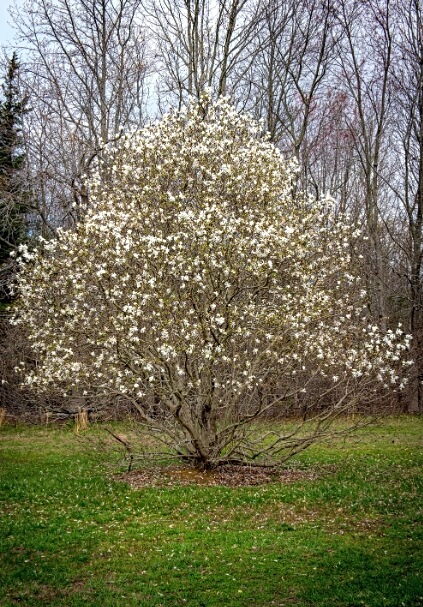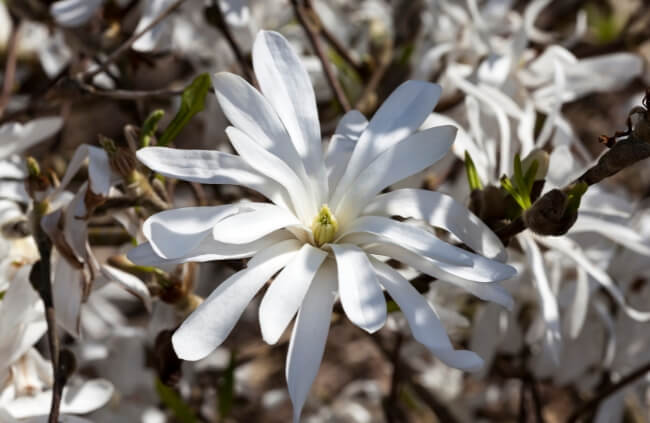Magnolia stellata is an instantly recognisable magnolia from its inflorescence. Commonly known as the Star Magnolia it is one of the earliest spring-flowering magnolias and has masses of fragrant, showy, star-shaped flowers.
Star magnolia is the smallest magnolia but one of the most popular for domestic gardens, favoured for its compact size and conical shape; it is perfect for small and big gardens alike.
More...

Family: | Magnoliaceae |
|---|---|
Genus: | |
Species: | M. Stellata |
Common names: | Star Magnolia, Starry Magnolia |
Origin: | Japan |
Location: | Outdoor |
Type: | Small trees or shrubs |
Growth: | 2.5m tall - 3m spread |
Sun requirements: | Semi shade |
Foliage colour: | Green |
Flower colour: | Pink or white |
Flowering: | Winter to spring |
Edible parts: | Flowers |
Maintenance level: | Low |
Poisonous for pets: | Not toxic to cats and dogs |
What is Magnolia stellata?
Magnolia stellata is closely related to Magnolia kobus; its overall shape and flower are quite similar in many ways, and these similarities are why scientists originally classed Magnolia stellata as a cultivar or variety of Magnolia kobus. However, it was later classified by botanists as its own distinct species in 1998.
Known most often as the Star Magnolia, Magnolia stellata is a slow-growing small to medium-sized shrub. Its eventual height is just 2.5m with a spread of up to 3m, forming a beautifully rounded to ovate shape.
A highly sought-after magnolia due to its early flowering, it is the first of the deciduous magnolias to flower in late winter to early spring providing much-needed nectar for wildlife and a captivating fragrance for gardeners.
Star Magnolia Plant Features
The blossoms of Magnolia stellata consist of strip-like tepals that look like delicate lengths of ribbon in shades of very pale pink and white. They have neither defined petal nor sepal in regards to their blossoms, which are fused together meaning that their flower ‘petals’ are technically tepals, like a tulip where the stem becomes bloom without anything in between.
Belonging to the family Magnoliacea, the star magnolia is part of this ancient genus, apparent on the landscape even before pollinating bees. It is thought that the blossoms evolved to suit pollination by beetles and flying beetles rather than the classic bee.
Once pollinated, Magnolia stellata will produce fruit that are not considered to be edible and can often contain toxins. The fruit is approximately 5cm long, green, and knobbly. This pod opens to reveal bright orange seeds inside.

Star Magnolia's Natural Habitat
Magnolia stellata grows naturally in moisture-retentive areas like stream sides, wetlands, and bogs. Though originally thought to be a native of Japan, Magnolia stellata was believed to grow only in Japan's mountainous regions in Nagoya City.
However, an extremely similar plant was found in China too, so indistinguishable that they were thought to be the same cultivar. This was until genetic research by botanists on this small group of a few hundred plants found it to be different and named it Magnolia sinostellata (from China).
Magnolia are one of the earliest plants in evolutionary history, with fossil records showing their presence in Asia, North America and Europe over 100 million years ago. Originally found growing across the globe, today the Magnoliacea family, indigenous to Asia, are found growing in the southeast United States.
Benefits and Uses of Magnolia stellata
The tepals of the magnolia flower are edible and have been consumed since ancient times. The tepals are often pickled and used as a spicy condiment or addition to English dishes. They can be tossed into a salad fresh from the plant, used as a flavour for rice in Asia or included in delicately scented teas.
Generally, most magnolia flowers are said to have a strong ginger and clove flavour. Magnolia stellata is noted to have a more bitter flavour so lends itself to pickling more than other uses. Along with their edible uses, magnolia is known to have medicinal uses too.
A recent study has found that the bark of magnolia is useful in the treatment of Parkinson's disease, reducing tremors. Some magnolia flower buds are used to relieve headaches and certain allergies in Asia.
Claims are made of magnolia's medicinal benefits for a whole host of mental and physical ailments including anxiety, digestive disorders, inflammation and even strokes.
How to Grow Magnolia stellata
Growing magnolia could not be simpler, however first and foremost it’s important to know that wild populations of Magnolia stellata have dramatically decreased due to increased urban development. Obtaining a Magnolia stellata from a reputable and sustainable source is of the highest importance.
Ideal Conditions for Growing Star Magnolia
Soil & Drainage
All magnolias do best when planted in fairly moisture-retentive soil with good drainage. They thrive in slightly acidic soil but will grow well in neutral and even slightly alkaline soils.
Magnolias are adaptable to most soil types, even heavy clay or drier, sandier, substrate; mature plants are moderately drought tolerant.
Light & Temperature
Depending on your area, magnolias tend to like a position in your garden that receives full sun to partial shade, but if you are in a warm and dry climate, a more shaded situation is best.
On very hot days, consider shading your magnolia with a temporary awning or if it is pot-grown, move to a less harsh corner with a bit of shelter.
Magnolia stellata is particularly frost tolerant and will survive low temperatures of up to -20°C if not sustained. Long periods of extreme frost will require the protection of your star magnolia.
Shelter
Prefers a sheltered sunny or semi-shaded spot which also has protection from being exposed to the elements. Magnolia have delicate flowers and strong winds can destroy the precious spring display of these plants.
Planting Magnolia stellata
Their preference for slightly acidic soil may potentially influence their surrounding planting so consider growing your star magnolia in a container giving it the perfect conditions it desires.
This will also make sheltering and protecting your magnolia much easier if you have a portable self-contained plant.
How to Propagate Magnolia stellata
Magnolia stellata has many successful options to choose from for propagation, but cuttings are the most reliable in terms of producing an identical plant to its parent.

Propagating Star Magnolia from Seeds
In autumn, magnolia will produce seed which is best left on the plant attached to the fruit to overwinter. The seed will need a period of stratification where it experiences low temperatures to trigger it into germinating.
It can also be done by storing the seed in a freezer for a few months to replicate a winter climate. Alternatively, you can wash the aril from around the seed and then place it in a polythene bag of moist vermiculite or perlite.
When collecting seed from a magnolia, it is best to find out what variety it is as hybrid magnolias or grafted plants may look very different once the seed is grown.
Using peat-free seed compost, sow the seeds in pots sparsely and cover lightly. Keep protected until germination which can be slow. Bear in mind that magnolias grown from seed take up to 10 years to flower.
Magnolia stellata Propagation from Cuttings
Magnolia stellata can also be grown from cuttings in spring or when you see new growth and is a much faster way of producing new plants. Using either softwood new growth as cutting material or semi-ripe hardwood, try to include at least two nodes when choosing a cutting.
Once cuttings are prepared, take a knife and scar or wound the outside of a node by just slicing through the skin on the stem, this will give rooting hormone something to stick to and activate the plant’s ability to develop adventitious roots. Rooting hormones such as powder or gel can be used by personal preference.
Push your cutting into some peat-free compost with added drainage, positioning the cuttings around the edges of a pot will give them stability. Water in the cuttings and cover it all with either a propagator lid or clear plastic bag to retain moisture, and keep the seedlings from drying out.
How to Care for Magnolia stellata

Magnolias are very easy to care for, another reason why they are such a popular, ornamental garden shrub. But there are some simple things you can do to either give your new magnolia the best start in life or keep your established specimen strong and healthy.
Always make sure you are using the best soil, especially when initially planting your magnolia. Using peat-free ericaceous compost or an acidic potting mix between 5-6 pH will help your plant to settle in well.
It is important to keep your star magnolia well-watered during its first year of planting. Adding a peat-free ericaceous mulch to the top layer of surrounding soil will help retain moisture; this mulch can also be bark chippings as this is also acidic. Other mulch can also be used as anything will help with moisture retention.
Star magnolia is pretty low maintenance and does not require any special pruning routines. However, it is always advantageous to take off any dead, diseased or dying branches for the overall health of your shrub.
How to Prune Magnolia stellata
Make sure to prune after flowering so as not to miss out on those blossoms. Magnolia stellata is known for its attractive, bushy habit so remember this if you are forcing your plant into an unnatural shape.
Tip pruning of your stellata can be beneficial encouragement for bushy growth if your shrub has a hollow area you want to fill. Be selective on where you prune, taking out the tip will trigger side shoots and give your magnolia a better shape.
Repotting Starry Magnolia
Growing magnolia in pots is a very successful way to care for your plant’s specific needs. This includes knowing when to repot your plant and scale up the size of the pot to give it room enough to grow.
Magnolia stellata are smaller specimens than most in the genus, but will still require a big enough root run for optimal growth. Their shallow roots lend themselves to container growing but a good rule of thumb is looking at the girth of the trunk.
Allow at least 30cm of pot space in diameter for each 1cm of trunk, scaling up as it grows thicker, this goes for the depth of the pot also. Make sure to keep any graft section of your plant above the surface of the soil and always use peat-free acidic or ericaceous compost when repotting.
Common Star Magnolia Pests and Diseases
Generally, magnolia do not suffer much from insect infestations, any damage they do get should not be detrimental. However, they can develop some general signs that the plant is not entirely happy.
Yellowing leaves can be a sign of an incorrect soil pH causing defoliation as the plant struggles to maintain itself. This could also be a sign of lack of water, sunburn, or heat stress.
Smaller insects such as grasshoppers, caterpillars and beetles can cause superficial damage to leaves, this will not cause harm to your magnolia.
However, any unchecked and persistent pest damage can lead to the weakening of the plants or wounds where infections can enter. Staying vigilant and either removing pests by hand or spraying with water will dislodge them. Encourage beneficial predators to keep your garden in a happy ecological balance.
Bacterial and Fungal Problems
Magnolia can be susceptible to bacterial and fungal problems. Leaf spots will present as black, brown, or even red patches on your magnolia leaves, these spots may have a yellow outer halo.
Exacerbated by wet and humid conditions it can pass from plant to plant through insects, wind, water, and plant debris. These patches are generally not detrimental to established plants, but the treatment of younger plants may be necessary by removing any diseased foliage, increasing airflow and watering control.
Leaf blight often looks like bacterial or fungal spots, but is usually more centralised with larger areas of black or browned leaf from the tip through the central vein. Lead blight is often characterised as ‘tip dieback.’
Treatment and control are much the same as with any fungal and bacterial infections, removing all affected foliage. A brutal prune may make all the difference as an infected magnolia trunk can be fatal.
However, young trees are unlikely to survive if Verticillium Wilt is present. All affected plants should be removed to stop the spread.
Magnolia stellata Frequently Asked Questions

Is Magnolia stellata frost hardy?
Magnolia stellata is entirely frost hardy, but late winter or early spring frost can damage flowers and developing buds, potentially limiting that year’s flowers.
Is Magnolia stellata evergreen?
Magnolia stellata is an evergreen tree that can lose its leaves in very cold winters. However, throughout Australia it has been proven in most gardens to be completely evergreen, producing flowers in late winter more reliably as a result.
Does Magnolia stellata need ericaceous compost?
Magnolia stellata prefers neutral to slightly acidic soil, so planting entirely in ericaceous compost will work, but it is best to mix ericaceous compost with topsoil or regular peat-free garden compost for more lightly acidic results.
How long is the lifespan of Magnolia stellata?
Magnolia stellata has a long lifespan with no real restrictions. They generally live for decades, but there are specimens known to be several hundred years old in parks and gardens.
Can Magnolia trees be moved?
Magnolia trees can be moved, but they tend to be shocked by the process, often failing to flower the following year as a result. If moving magnolia trees in pots, do so either during summer or before flowering in winter.
Established magnolia trees in the ground will not react well to being moved so avoid it unless it is entirely necessary.
Enjoy the Beauty of Magnolia stellata in Your Garden
The ethereal beauty of Magnolia stellata can have you magnetised to magnolias, especially with its star-themed inflorescence, shining out on a dark spring evening. It quite literally brightens up the night sky and is usually the last flower you’ll see in the garden as the sun sets.
Growing your own Magnolia stellata isn’t just about the tree itself, it's about what it means for the garden. Thanks to its late winter flowers, it is a promise of a season of growth yet to come.
Published on October 18, 2023 by Maisie Blevins
Last Updated on April 15, 2024




